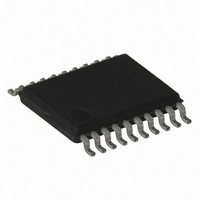ATTINY167-15XD Atmel, ATTINY167-15XD Datasheet - Page 151

ATTINY167-15XD
Manufacturer Part Number
ATTINY167-15XD
Description
MCU AVR 16K FLASH 15MHZ 20-TSSOP
Manufacturer
Atmel
Series
AVR® ATtinyr
Datasheet
1.ATTINY167-15MD.pdf
(283 pages)
Specifications of ATTINY167-15XD
Core Processor
AVR
Core Size
8-Bit
Speed
16MHz
Connectivity
I²C, LIN, SPI, UART/USART, USI
Peripherals
Brown-out Detect/Reset, POR, PWM, Temp Sensor, WDT
Number Of I /o
16
Program Memory Size
16KB (8K x 16)
Program Memory Type
FLASH
Eeprom Size
512 x 8
Ram Size
512 x 8
Voltage - Supply (vcc/vdd)
2.7 V ~ 5.5 V
Data Converters
A/D 11x10b
Oscillator Type
Internal
Operating Temperature
-40°C ~ 150°C
Package / Case
20-TSSOP
Processor Series
ATTINY1x
Core
AVR8
Data Bus Width
8 bit
Data Ram Size
512 B
Maximum Clock Frequency
16 MHz
Maximum Operating Temperature
+ 85 C
Mounting Style
SMD/SMT
3rd Party Development Tools
EWAVR, EWAVR-BL
Development Tools By Supplier
ATAVRDRAGON, ATSTK500, ATSTK600, ATAVRISP2, ATAVRONEKIT
Minimum Operating Temperature
- 40 C
For Use With
ATSTK600-SOIC - STK600 SOCKET/ADAPTER FOR SOIC
Lead Free Status / RoHS Status
Lead free / RoHS Compliant
- Current page: 151 of 283
- Download datasheet (5Mb)
14.3.2
7728G–AVR–06/10
SPI Master Operation Example
The clock is generated by the Master device software by toggling the USCK pin via the PORT
Register or by writing a one to the USITC bit in USICR.
Figure 14-3. Three-wire Mode, Timing Diagram
The Three-wire mode timing is shown in
reference. One bit is shifted into the USI Data Register (USIDR) for each of these cycles. The
USCK timing is shown for both external clock modes. In External Clock mode 0 (USICS0 = 0),
DI is sampled at positive edges, and DO is changed (Data Register is shifted by one) at nega-
tive edges. External Clock mode 1 (USICS0 = 1) uses the opposite edges versus mode 0, i.e.,
samples data at negative and changes the output at positive edges. The USI clock modes cor-
responds to the SPI data mode 0 and 1.
Referring to the timing diagram
The following code demonstrates how to use the USI module as a SPI Master:
CYCLE
1. The Slave device and Master device sets up its data output and, depending on the
2. The Master generates a clock pulse by software toggling the USCK line twice (C and
3. Step 2. is repeated eight times for a complete register (byte) transfer.
4. After eight clock pulses (i.e., 16 clock edges) the counter will overflow and indicate
USCK
USCK
DO
SPITransfer:
SPITransfer_loop:
DI
protocol used, enables its output driver (mark A and B). The output is set up by writ-
ing the data to be transmitted to the USI Data Register. Enabling of the output is done
by setting the corresponding bit in the port Data Direction Register. Note that point A
and B does not have any specific order, but both must be at least one half USCK
cycle before point C where the data is sampled. This must be done to ensure that the
data setup requirement is satisfied. The 4-bit counter is reset to zero.
D). The bit value on the slave and master’s data input (DI) pin is sampled by the USI
on the first edge (C), and the data output is changed on the opposite edge (D). The
4-bit counter will count both edges.
that the transfer is completed. The data bytes transferred must now be processed
before a new transfer can be initiated. The overflow interrupt will wake up the proces-
sor if it is set to Idle mode. Depending of the protocol used the slave device can now
set its output to high impedance.
( Reference )
sts
ldi
sts
ldi
A
USIDR,r16
r16,(1<<USIOIF)
USISR,r16
r16,(1<<USIWM0)|(1<<USICS1)|(1<<USICLK)|(1<<USITC)
B
MSB
MSB
C
1
D
2
6
6
(Figure
3
5
5
14-3), a bus transfer involves the following steps:
Figure 14-3
4
4
4
5
At the top of the figure is a USCK cycle
3
3
ATtiny87/ATtiny167
6
2
2
7
1
1
LSB
LSB
8
E
151
Related parts for ATTINY167-15XD
Image
Part Number
Description
Manufacturer
Datasheet
Request
R

Part Number:
Description:
Manufacturer:
Atmel Corporation
Datasheet:

Part Number:
Description:
Manufacturer:
Atmel Corporation
Datasheet:

Part Number:
Description:
MCU AVR 16K FLASH 15MHZ 32-QFN
Manufacturer:
Atmel
Datasheet:

Part Number:
Description:
IC MCU AVR 16K FLASH 20TSSOP
Manufacturer:
Atmel
Datasheet:

Part Number:
Description:
MCU AVR 16K FLASH 15MHZ 32-QFN
Manufacturer:
Atmel
Datasheet:

Part Number:
Description:
MCU AVR 16K FLASH 15MHZ 20-SOIC
Manufacturer:
Atmel
Datasheet:

Part Number:
Description:
MCU AVR 16K FLASH 15MHZ 20-TSSOP
Manufacturer:
Atmel
Datasheet:

Part Number:
Description:
IC MCU AVR 16K FLASH 20SOIC
Manufacturer:
Atmel
Datasheet:










